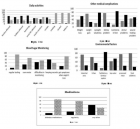Abstract
Research Article
The Stability and Behaviour of the Superposition of Non-Linear Waves in Space
Christopher O Adeogun*
Published: 29 December, 2023 | Volume 6 - Issue 2 | Pages: 216-221
The superposition of non-linear waves in space refers to the phenomenon where two or more waves overlap and combine to form a new wave pattern. Non-linear waves are characterized by their ability to interact with each other, leading to complex behaviors that are not observed in linear wave systems. Understanding the stability and behavior of the superposition of non-linear waves in space is crucial in various fields such as physics, engineering, and oceanography.
When non-linear waves superpose, their interactions can lead to a range of behaviors, including wave breaking, formation of solitons (localized wave packets), and the generation of harmonics. The stability of the superposition is determined by the balance between the non-linear effects and dispersive effects, which can either stabilize or destabilize the wave pattern. In addition, the behavior of non-linear waves in space is influenced by external factors such as boundaries, dissipation, and external forcing.
In this paper, we study the behavior and characteristics of waves when they interact with each other. Superposition refers to the phenomenon where multiple waves combine to form a resultant wave. In the case of linear waves, this superposition occurs according to the principles of linear superposition, which states that the displacement or amplitude at any point is the algebraic sum of the displacements or amplitudes of the individual waves.
Understanding the superposition of linear waves in space has various applications in fields such as physics, engineering, acoustics, optics, and signal processing. By studying how waves interact and combine, researchers can gain insights into wave propagation, interference patterns, wave reflections, diffraction, and other phenomena that occur when waves meet.
Read Full Article HTML DOI: 10.29328/journal.ijpra.1001075 Cite this Article Read Full Article PDF
References
- Boyd RW. Nonlinear optics (3rd ed.). Academic Press. (Print). 2008.
- Akhmediev N, Ankiewicz A. Solitons: Nonlinear pulses and beams. Chapman & Hall/CRC. (Print). 2005.
- Kivshar YS, Agrawal GP. Optical solitons: From fibers to photonic crystals. Academic Press. (Print). 2003.
- Hasegawa A, Tappert F. Transmission of stationary nonlinear optical pulses in dispersive dielectric fibers: I. Anomalous dispersion. Applied Physics Letter. 1973; 23(3): 142-144. doi:10.1063/1.1654836 (Web)
- Dudley J, Coen S. Supercontinuum generation in photonic crystal fiber (2nd ed.). Cambridge University Press. (Print). 2019.
- Andrews DL, Babiker M. The angular momentum of light. Cambridge University Press. (Print). 2003.
- Kevrekidis PG, Frantzeskakis DJ, Carretero-González R. Emergent nonlinear phenomena in Bose-Einstein condensates: Theory and experiment. Springer Science & Business Media. (Print). 2009.
- Whitham GB. Linear and nonlinear waves. John Wiley & Sons. (Print)
- Newell A, White J. Nonlinear Wave Phenomena. Cambridge University Press. 2000.
- Achenbach PAR. Nonlinear Wave Propagation. Academic Press. 1977.
- Camassa R, Holm P. Integrable Models of Wave Propagation with Dispersive Shock Waves. SIAM J Appl Math. 1996; 56: 1531-1560.
- Newell A, J White’s book provides a comprehensive overview of nonlinear wave phenomena, including their properties, characteristics, and the impact of external forces and perturbations.
- Superposition of Waves: A Concise Overview - By Dr. David B. Tabor, published in the Journal of the Acoustical Society of America.
Figures:
Similar Articles
-
High energy HF (DF) lasersVictor V Apollonov*. High energy HF (DF) lasers. . 2018 doi: 10.29328/journal.ijpra.1001001; 1: 001-016
-
Magnetohydrodynamic CNTs Casson Nanofluid and Radiative heat transfer in a Rotating ChannelsZahir Shah*,Abdullah Dawar,Saeed Islam,Muhammad Idress,Waris Khan. Magnetohydrodynamic CNTs Casson Nanofluid and Radiative heat transfer in a Rotating Channels. . 2018 doi: 10.29328/journal.ijpra.1001002; 1: 017-032
-
Sounding procedure for characterization of big fusion reactor chambers by means of a compact neutron source with a nanosecond pulse durationVA Gribkov*,B Bienkowska,S Jednorog,M Paduch,Tomaszewski. Sounding procedure for characterization of big fusion reactor chambers by means of a compact neutron source with a nanosecond pulse duration. . 2018 doi: 10.29328/journal.ijpra.1001003; 1: 033-051
-
Gravitation - Flat Power FieldSA Orlov*. Gravitation - Flat Power Field. . 2018 doi: 10.29328/journal.ijpra.1001005; 1: 067-073
-
Moving space-matter as the basis of the intelligence in the Physical WorldBoris S Dizhechko*. Moving space-matter as the basis of the intelligence in the Physical World. . 2019 doi: 10.29328/journal.ijpra.1001007; 2: 001-003
-
Nanotechnology to improve the biofouling and corrosion performance of marine paints: from lab experiments to real tests in seaGeorge Kordas*. Nanotechnology to improve the biofouling and corrosion performance of marine paints: from lab experiments to real tests in sea. . 2019 doi: 10.29328/journal.ijpra.1001012; 2: 033-037
-
Biological membranes: The laboratory of fundamental physicsSamo Kralj*,Mitja Kralj. Biological membranes: The laboratory of fundamental physics. . 2019 doi: 10.29328/journal.ijpra.1001013; 2: 038-040
-
Biodegradation of gold and platinum implants in rats studied by electron microscopyLudwig Jonas*,Hendrik Kosslick,Hermann Sauer,Tino Just,Ursula Vick,Gerhard Fulda. Biodegradation of gold and platinum implants in rats studied by electron microscopy. . 2019 doi: 10.29328/journal.ijpra.1001014; 2: 041-048
-
Modeling of A.I based Inhalation for Advanced Life Support System DevelopmentMd. Sadique Shaikh*,Tanvir Begum. Modeling of A.I based Inhalation for Advanced Life Support System Development. . 2019 doi: 10.29328/journal.ijpra.1001015; 2: 049-050
-
Bio-moleculear thermal oscillator and constant heat current sourceR Panahinia*,S Behnia. Bio-moleculear thermal oscillator and constant heat current source. . 2019 doi: 10.29328/journal.ijpra.1001016; 2: 051-055
Recently Viewed
-
Association Between Electrocardiographic Abnormalities and In-Hospital Adverse Outcome in COVID-19 PatientsAnjuman Begum*, Wadud Chowdhury, Suman KS, Arnab KC, Md. Akteruzzaman, Barua Sushanta. Association Between Electrocardiographic Abnormalities and In-Hospital Adverse Outcome in COVID-19 Patients. J Cardiol Cardiovasc Med. 2024: doi: 10.29328/journal.jccm.1001196; 9: 148-152
-
Maximizing the Potential of Ketogenic Dieting as a Potent, Safe, Easy-to-Apply and Cost-Effective Anti-Cancer TherapySimeon Ikechukwu Egba*,Daniel Chigbo. Maximizing the Potential of Ketogenic Dieting as a Potent, Safe, Easy-to-Apply and Cost-Effective Anti-Cancer Therapy. Arch Cancer Sci Ther. 2025: doi: 10.29328/journal.acst.1001047; 9: 001-005
-
Parents’ perception of the school nurse’s roleDiane Gillooly*,Ganga Mahat,Patricia Paradiso. Parents’ perception of the school nurse’s role. J Adv Pediatr Child Health. 2020: doi: 10.29328/journal.japch.1001021; 3: 064-067
-
Plant growth, Yield and Leaf Nutritional value of Jute (Corchorus olitorius L.) as Influenced by Banana Peel levels under Salt Stress conditions in Coastal region of CameroonMathias Julien Hand*,Chimène Fanta Abib,Kingsley Mbi Tabi,Alphonse Ervé Nouck,Libert Brice Tonfack,Victor Désiré Taffouo,Emmanuel Youmbi. Plant growth, Yield and Leaf Nutritional value of Jute (Corchorus olitorius L.) as Influenced by Banana Peel levels under Salt Stress conditions in Coastal region of Cameroon. J Plant Sci Phytopathol. 2024: doi: 10.29328/journal.jpsp.1001145; 8: 131-140
-
Dynamics of Siberian Fir Stands in Forest Ecosystems of Eastern Sayan SpursBazhina Elena Vasil’evna*,Pavel I Aminev. Dynamics of Siberian Fir Stands in Forest Ecosystems of Eastern Sayan Spurs. J Plant Sci Phytopathol. 2024: doi: 10.29328/journal.jpsp.1001146; 8: 141-143
Most Viewed
-
Evaluation of Biostimulants Based on Recovered Protein Hydrolysates from Animal By-products as Plant Growth EnhancersH Pérez-Aguilar*, M Lacruz-Asaro, F Arán-Ais. Evaluation of Biostimulants Based on Recovered Protein Hydrolysates from Animal By-products as Plant Growth Enhancers. J Plant Sci Phytopathol. 2023 doi: 10.29328/journal.jpsp.1001104; 7: 042-047
-
Sinonasal Myxoma Extending into the Orbit in a 4-Year Old: A Case PresentationJulian A Purrinos*, Ramzi Younis. Sinonasal Myxoma Extending into the Orbit in a 4-Year Old: A Case Presentation. Arch Case Rep. 2024 doi: 10.29328/journal.acr.1001099; 8: 075-077
-
Feasibility study of magnetic sensing for detecting single-neuron action potentialsDenis Tonini,Kai Wu,Renata Saha,Jian-Ping Wang*. Feasibility study of magnetic sensing for detecting single-neuron action potentials. Ann Biomed Sci Eng. 2022 doi: 10.29328/journal.abse.1001018; 6: 019-029
-
Pediatric Dysgerminoma: Unveiling a Rare Ovarian TumorFaten Limaiem*, Khalil Saffar, Ahmed Halouani. Pediatric Dysgerminoma: Unveiling a Rare Ovarian Tumor. Arch Case Rep. 2024 doi: 10.29328/journal.acr.1001087; 8: 010-013
-
Physical activity can change the physiological and psychological circumstances during COVID-19 pandemic: A narrative reviewKhashayar Maroufi*. Physical activity can change the physiological and psychological circumstances during COVID-19 pandemic: A narrative review. J Sports Med Ther. 2021 doi: 10.29328/journal.jsmt.1001051; 6: 001-007

HSPI: We're glad you're here. Please click "create a new Query" if you are a new visitor to our website and need further information from us.
If you are already a member of our network and need to keep track of any developments regarding a question you have already submitted, click "take me to my Query."

















































































































































